Perhaps it always rains on Sunday, and anyway it never rains but it pours. Two Blu-ray labels, Film Movement and Kino Lorber, are currently unleashing restorations from the library of Ealing Studios, one of the most celebrated British film companies. Ealing became synonymous with comedy but, as we shall see, that wasn’t its only bailiwick. The releases, some of which have never been properly available in Region 1, will continue further into 2020 as licensed from StudioCanal, and here are some initial titles.
It Always Rains on Sunday, Dir. Robert Hamer, 1947. [Kino Lorber]
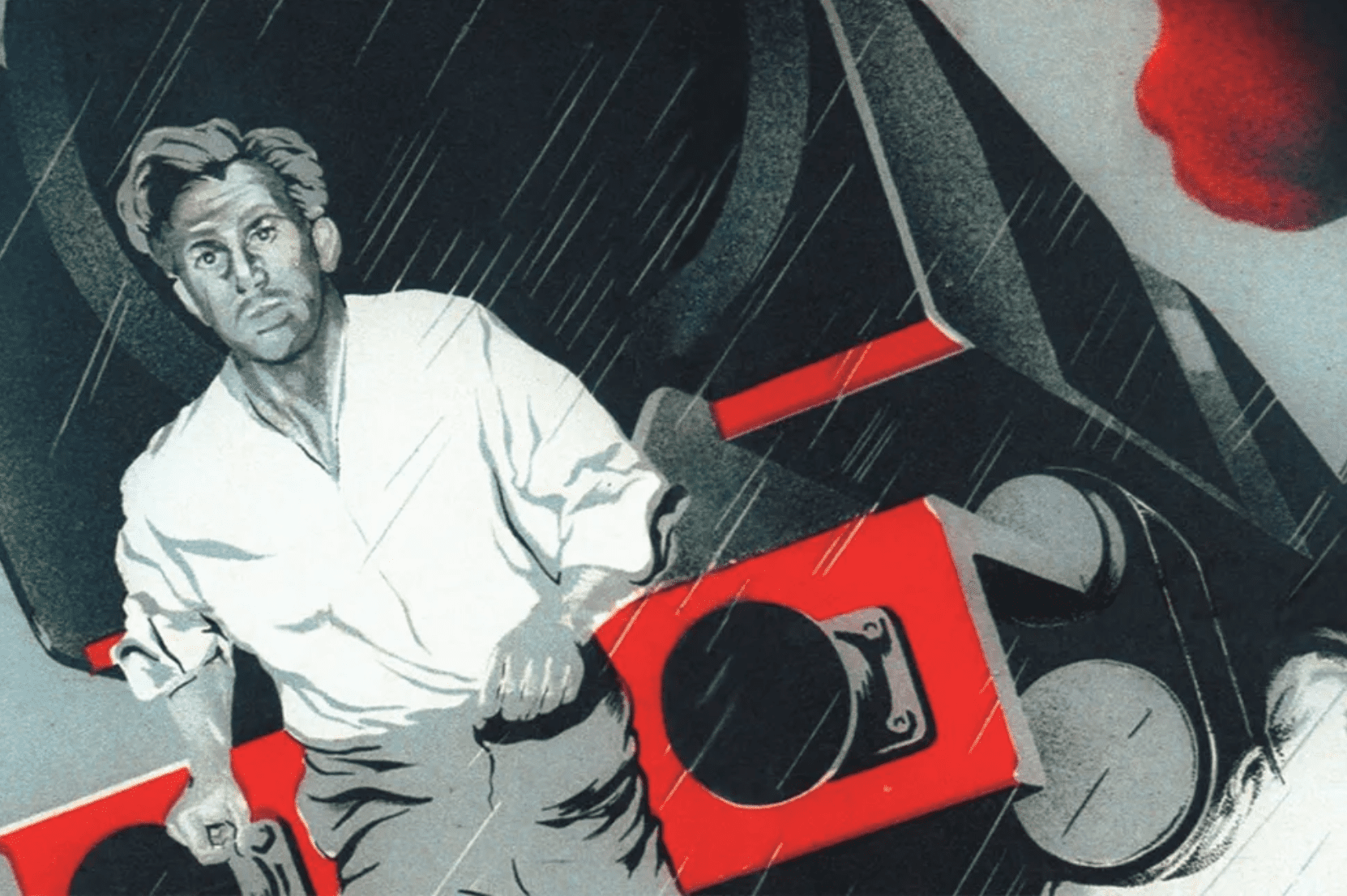
(image: excerpted from Kino Lorber Blu-ray cover)
Ealing Studios is the oldest continuously running film studio in the world, having its origins in 1902 under producer Will Barker. Basil Dean bought the facility in 1929 and renamed it Associated Talking Pictures. The Ealing Studios moniker came into being with new owner Michael Balcon in 1938. In the late ’40s and ’50s, Ealing launched a successful series of comedies that took place in heavily populated, fully realized worlds. Alec Guinness emerged as the studios’ biggest and most chameleon-like comedy star, and Peter Sellers caught attention there.
However, Ealing wasn’t all comedy. During WWII and shortly after, they made war pictures and gritty dramas, such as Alberto Cavalcanti’s Went the Day Well? (1942), now scheduled for a March Blu-ray release from Film Movement. Perhaps the studio’s greatest drama is Robert Hamer’s It Always Rains on Sunday (1947), which hasn’t been very well known in the US but whose reputation has steadily grown in England since its initial and somewhat controversial success.
The story takes place in March 1947, in Bethnal Green, a bustling working-class neighborhood in London’s East End. The panoramic story weaves the interactions of three “families” that are struggling through postwar England’s depressed age of austerity and ration cards. With its Jewish characters and even one glimpse of a black man in the middle of the crowded market, this may be the most multicultural snapshot of England’s late ’40s cinema.
The middle-class family at the center is the Sandigates, living uneasily in a cramped house redolent of frustration. Rose (Googie Withers) is the second wife of portly, phlegmatic, darts-and-bitters George (Edward Chapman). She’s continually sniping at the adult stepdaughters who share a bed: blonde and vivacious Vi (Susan Shaw) and mousy brunette Doris (Patricia Plunkett). It’s a household and neighborhood marked by those two stolid symbols of the English aspirational would-be-genteel class: the budgerigar and the aspidistra. One scene even has both, and the symbolism of the caged bird won’t be lost on many viewers.
What makes Rose tolerable instead of tiresome as a heroine is the canny use of flashbacks, triggered by mirrors, that compare the at-odds Rose and Vi. The latter’s flashback is only to the night before, when she came home late from a date with a married shop owner and jazz band leader who’s handing her a line about her singing talent.
Rose’s flashback goes before the war and before her marriage, when she was swept off her feet by the tall, handsome, flashy Tommy Swann (John McCallum, who married Withers). In a daringly erotic composition, they’re seen in a rural idyll with Rose’s head resting on his crotch. No sooner has he proposed marriage with a ring than he’s arrested for armed robbery and sent to Dartmoor.
When this flashback is over, the viewer understands that Rose’s petty crabbing at her family, especially her nubile young stepdaughters, is how she expresses frustration with her own thwarted life, the consolation-prize second-place settlement of it. In other words, she’s like many a viewer, and many a housewife sitting in the audience.
Almost the first information the movie presents in its swift, smoothly flowing style is that Tommy has escaped from prison. The film cuts from a headline to an image of him stumbling down a hill and falling across a railroad track, which foreshadows the thrillingly shot final chase through a railway yard, when the film escalates from slice-of-life with suspenseful and comic elements into full-blown noir on a level with Carol Reed’s The Third Man (1949).
The second family is the Hyams siblings, a Jewish family with a respectable sister and equally respectable father who runs a news-agent’s shop. However, the story focuses on the more dubious brothers. Morry (Sydney Tafler) is the married “schlemiel” and jazzman making a play for Vi while his wife (Betty Ann Davies) observes from the sidelines and comments on his “shiksas”. The more successful and ambiguous Lou (John Slater) is a wheeler-dealer with a finger in many pies, like fixed boxing matches, and he offers Doris a job that may or may not be on the level.
The third “family” is three low-level “spivs”, petty criminals on the black market whose escapades are a series of humiliations and ambitions as cruelly thwarted as everyone else’s. Continually dogged by a local cop (Jack Warner), they’re a kind of hapless chorus, although one of them will commit to a grim decision out of his frustrated rage.
All the characters are presented as “no better than they should be”, to employ a British-ism, and the implication is that all England is reduced to scrounging and fiddling in the bitter postwar rebuilding, at least among those who aren’t privileged toffs. The central suspense is generated by Rose’s being confronted by the runaway Tommy, who emerges like a wraith from the shadows of her “Anderson”, or air-raid shelter. All the old feelings come unleashed inside her as she commits herself to helping him, even though the scales have fallen from her eyes. Indeed, it’s because she sees so clearly that her decision becomes heroic.
If we compare this vision to anything in Hollywood cinema, it might be William Wyler’s Depression-era
Dead End (1937). As Imogen Sara Smith points out in an excellent commentary, and as others mention in the bonus appreciation, the film belongs to a downbeat strain in England’s gritty urban noirs, to the London-shot Hollywood production of Jules Dassin’s Night and the City (1950) and the “kitchen sink” dramas of the late ’50s and ’60s. Smith observes that Hamer’s movie actually spends more time at the kitchen sink than those films. Another pertinent comparison is the vision of scrounging in Sweet Smell of Success (1957), a Hollywood noir directed by Ealing veteran Alexander Mackendrick.
It Always Rains on Sunday becomes a lyrical existential statement in which Hamer orchestrates a very large cast into a city symphony. He works from a script by himself and two crucial collaborators at Ealing: Angus MacPhail and Henry Cornelius, a South African Jew whom Smith speculates may have been responsible for the sympathetic portrayal of Jewish characters. He was brought to the studio, like most everyone else at the time, by Cavalcanti, who’d directed one of the first day-in-the-life “city symphonies”, the French Rien que les heures (1926).
The writers were adapting a novel by Arthur La Bern, a journalist who mined this kind of ground-level shady city portrait, and whose other most famous novel was adapted into Alfred Hitchcock’s
Frenzy (1972). Hamer’s vision as director and writer is aided immensely, especially during the noir segments, by Douglas Slocombe, one of the most celebrated English cinematographers. They’d collaborate again on Hamer’s biggest hit, Kind Hearts and Coronets, as we’ll get to shortly. First, Ealing had to begin laying down its comedy credentials.
Passport to Pimlico, Dir. Henry Cornelius, 1949. [Film Movement]
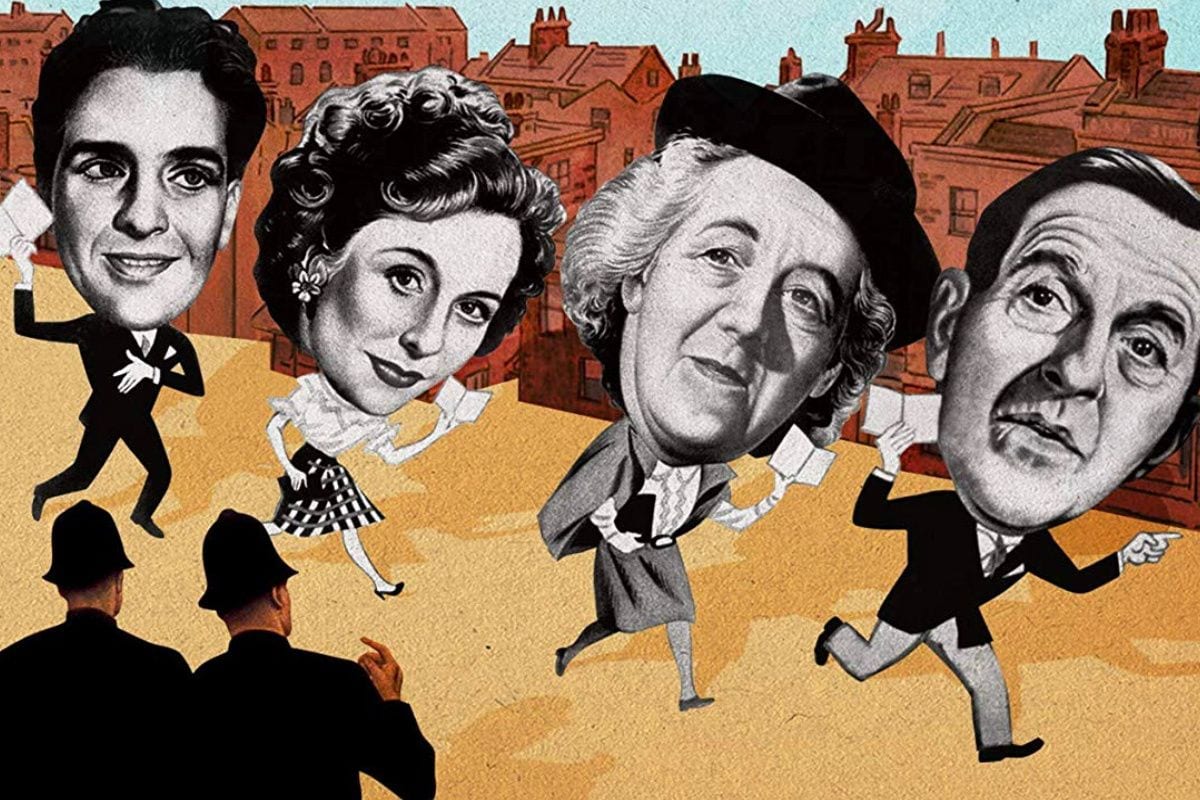
(image: excerpted from Film Movement Blu-ray cover)
Charles Crichton’s Hue and Cry (1947), a light-hearted thriller starring Alastair Sim, is commonly named as the first Ealing comedy; it’s scheduled for a February release from Film Movement with other Sim vehicles. Nevertheless, Cornelius’ Passport to Pimlico (1949) is Ealing’s first comic breakthrough in its classic template. If It Always Rains on Sunday presents a cohesive neighborhood in melancholy if boisterous tones, Cornelius’ film embodies the neighborhood as a lark’s nest of eccentrics, and literally self-contained.
Rooted firmly in its time and place, Passport to Pimlico opens in “the fond memory” of ration books, as if they’re a thing of the past. This gag must have brought cheers and groans from the English audience of 1949, for they were still in the thick of rationing, and the movie provides a fantasy of throwing aside all the rules under which they lived.
The opening shots give the false impression that the story takes place in some balmy tropical land before the story begins with another legacy of the war: an unexploded bomb being dug out of the street. Its explosion causes the discovery of a buried treasure, which leads an eccentric Prof. Hatton-Jones (Margaret Rutherford, nearly stealing the picture) to determine that the street and its citizens belong to a centuries-old province called Burgundy, independent of England. “Blimey, I’m a foreigner!” exclaims one citizen, catching the paradox of English provincial mistrust, not to say xenophobia.
A real foreigner arrives in the person of a Frenchman claiming to be the Duke of Burgundy (Paul Dupuis), and darned if he doesn’t set about stealing a girlfriend (Barbara Murray) from one of the frowning locals (John Slater). Other locals are played by Stanley Holloway, Hermione Baddeley, Raymond Huntley, Betty Warren, Jane Hylton, Philip Stainton, Sydney Tafler and Charles Hawtrey, for this is another of Ealing’s large-cast neighborhood movies.
In theory, an Act of Parliament could repeal the old proclamation, but the story never gets around to spoiling the fun that quickly. Instead, tensions escalate when people realize they can conduct black market business in this zone, and locals seek to prevent this influx of English “aliens” and “spivs” while celebrating their own abolition of rationing, licensing and other inconvenient laws.
The government, represented by Naunton Wayne and Basil Radford, whose careers were yoked together since their pairing in Alfred Hitchcock’s
The Lady Vanishes (1938), cuts off services and “closes the borders”, leading to local retaliation by blocking underground transport for customs checks. (For more bureaucratic customs comedy, wait for The Lavender Hill Mob below.)
“Oh, plucky little Burgundy!” declares a newsreel announcer as Pimlico digs in for the siege, cementing the identification of this street with England and its struggle with the Blitz, which would make Whitehall into “the Hun” or “the jerries”. As world sympathy falls with “the little guy”, there are even airdrops in parody of what was happening in Berlin.
Although the situation is frenetic and spins out of control, the humor is mild and cozy and celebratory of some kind of English spirit, belonging to what Mark Duguid’s bonus interview calls “the warm side” of Ealing comedies, the side that told viewers what they wanted to believe about themselves. The citizens are happier with this “war” than they were under the peacetime regulations, and the film functions as a wish-fulfillment fantasy, letting off steam in laughter.
The paradoxes of the story’s impulses are summarized when a woman shouts out the window, “We always were English and we always will be English, and it’s just because we are English that we’re sticking up for our right to be Burgundians!” Or as Ronald Bergan’s notes put it, “While poking some fun at the new Socialist-leaning Labour government, the film is too gentle and good humored to be classified as satire, though it has an accidental contemporary reference to Brexit.”
This film was the first of the studio’s three big comic hits that year in a short time, followed by Alexander Mackendrick’s similar community comedy,
Whiskey Galore! (scheduled for February release from Film Movement) and Hamer’s black comedy Kind Hearts and Coronets, a very different kettle of fish.
The Titfield Thunderbolt, Dir. Charles Crichton, 1953. [Film Movement Classics]
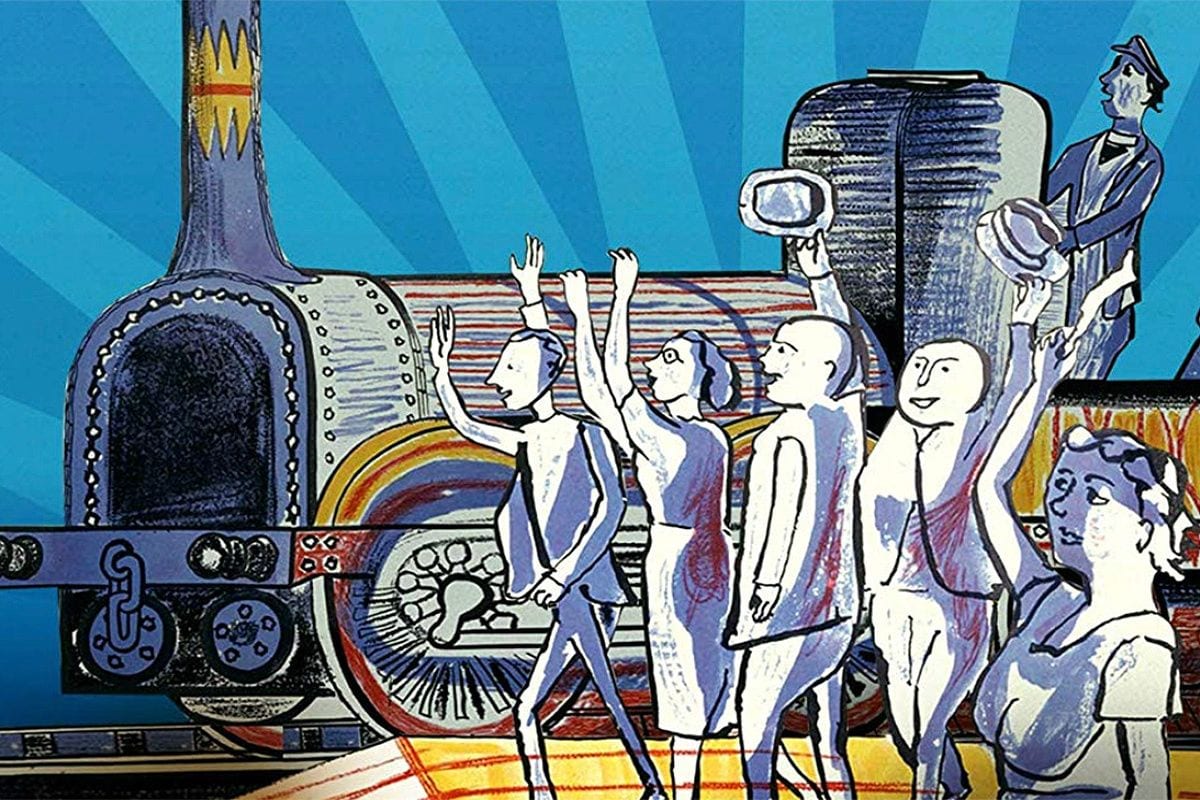
(image: excerpted from Film Movement Blu-ray cover)
Passport to Pimlico is one of many Ealings scripted by T.E.B. Clarke, who embodies that warm side, and his script for Charles Crichton’s The Titfield Thunderbolt (1953) feels like a close relation, also on the subject of letting off steam.
When a village’s locomotive branch line faces closure from the unsentimental public bureaucracy, the locals decide to run it privately. It’s the train-happy vicar’s idea, and when it’s pointed out that the Canterbury line was recently closed, he intones the film’s wittiest line: “Perhaps there weren’t men of sufficient faith in Canterbury.” Faith is necessary to make the trains run (almost) on time, for both a vicar and a bishop ultimately run the Titfield engine, so make of that what you will.
These forces of conservation, nostalgia, and the old guard face opposition from two jumped-up working-class rivals who own a bus. The latter are unscrupulous modern capitalists while the vicar (George Relph), the squire (John Gregson), the bishop (Godfrey Tearle) and a free-drinking rich man (Stanley Holloway) who run the volunteer railroad are terrified of making a profit for fear they’d be nationalized. The squire tells a unionist that there’s no difference between capital and labor in their enterprise.
A highlight of the story is when a hijacked engine barrels through the streets of town, literally off the rails, all scored with a jolly bounce by Georges Auric, composer for It Always Rains on Sunday and Passport to Pimlico. As Slocombe mentions in an extra, he chose to shoot this sequence day-for-night, which obscured the fact that the engine was, in fact, an ordinary truck (or “lorry” as he calls it) with a specially molded chassis and smoke-pots belching steam. His 16mm color home movies show how these scenes looked in daylight, and it’s still mighty impressive; that footage is great documentation and the most interesting extra.
The Titfield Thunderbolt has three primary attractions. One is the familiar array of actors doing their thing, including Naunton Wayne as the town clerk, Hugh Griffith as the drunken rascal of an engineer, Jack MacGowran as the bus owner, Sid James as the steamroller driver, and Edie Martin as a game little old lady a bit like Granny Clampett of The Beverly Hillbillies.
The second attraction is the spectacle of all the choo-choos, especially the colorful title engine like a shiny toy puffing away. One of the extras tells the long history of this engine going back to 1838; it still exists. Trainspotting is a particularly English obsession, like steak and kidney pie only healthier.
The third attraction is Slocombe’s yummy Technicolor photography, which highlights the lilting greens of the Somerset countryside in what comes across as everyone’s fantasy of England’s “green and pleasant land” — as opposed to the rainy London of
It Always Rains on Sunday and the last scene of Passport to Pimlico, when the official rejoining with England is signaled by a downpour.
Clarke’s script was inspired by the first volunteer railway line in Wales. As people observe in the brief extras, the handwriting really was on the wall for steam trains, while the idea of private volunteer lines would gain traction years later. Today, many such “heritage railways” act as a kind of living museum.
Kind Hearts and Coronets, Dir. Robert Hamer, 1959. [Kino Lorber]
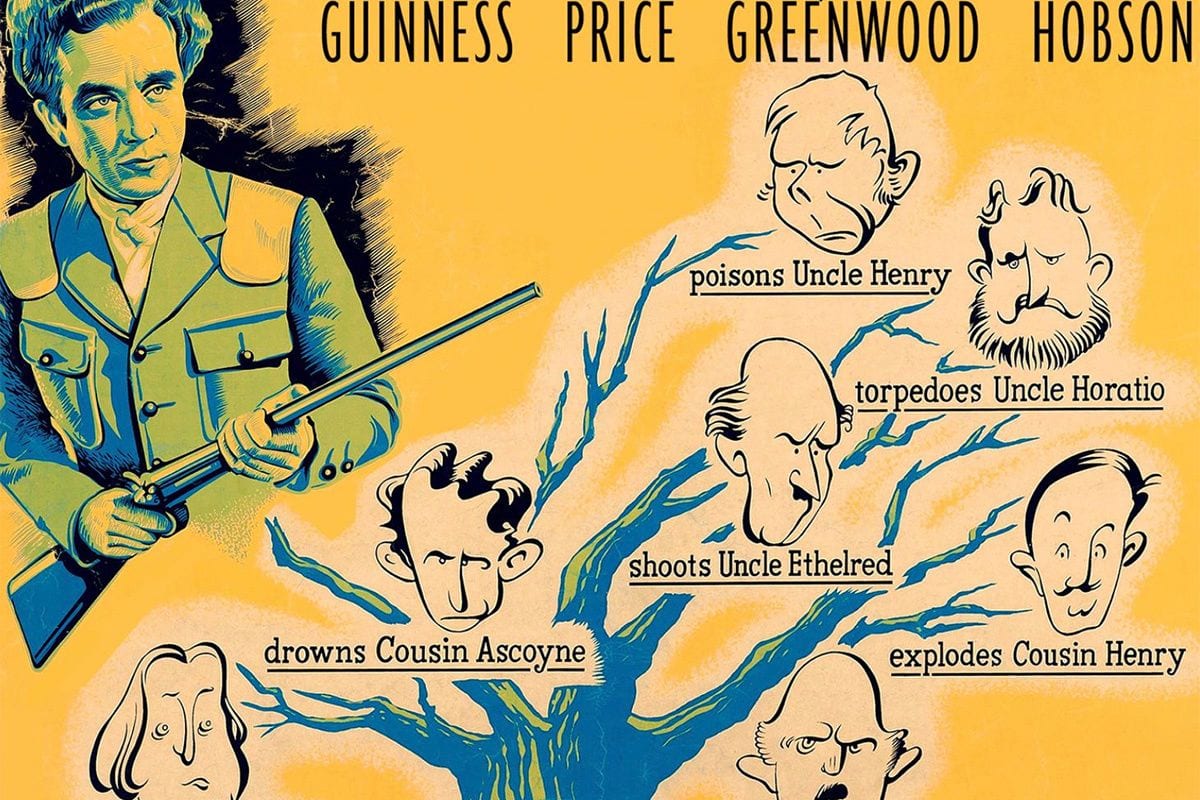
Alec Guinness became an international star thanks to his string of Ealing comedies. Kino Lorber showcases his diversity in three of them: Hamer’s Kind Hearts and Coronets, Crichton’s The Lavender Hill Mob (1951) and Mackendrick’s The Man in the White Suit (1951), which provide a kaleidoscope of tones, emotions, and types of comedy.
Kind Hearts and Coronets, Hamer’s biggest success, remained Ealing’s darkest bon-bon until the glorious Technicolor apotheosis of Mackendrick’s The Lady Killers (1955), starring Guinness and Peter Sellers.
Hamer’s comedy of murder takes place early in the 20th century under the narration of Louis D’Ascoyne Mazzini, played with aristocratic sang-froid by Dennis Price. Mazzini’s grudge against the D’Ascoyne family is that when his high-born mother (Audrey Fildes) married beneath her class for love, she was shunned and couldn’t even be buried in the family vault.
Then, when the woman he loves, Sibella (Joan Greenwood), turns him down for a rich bore, Mazzini calmly sets about inheriting his family’s dukedom by knocking off all eight relatives who stand in his way. In the movie’s most delicious conceit, they’re all played by Guinness.
Mazzini is so forthcoming because he’s writing his memoirs from his prison cell, where he awaits execution the next day. Most of the film’s events are recounted in flashback, and most are dry and elegant. This is one of the earliest “body count” movies, and a comedy at that. Viewers can only delight in Mazzini’s murderous ingenuities and the Guinness masquerades, which include one female character.
Because we’re talking about cartoonish upper-class twits, nobody wastes much sympathy on them, and Kind Hearts and Coronets becomes a vicarious example of class revenge and the ultimate fantasy of social-climbing. Aside from his suffering years of humiliation with a good temper, one detail that renders Mazzini more sympathetic is that he shows real anger at slights to his mother.
When someone refers to her running away with an “organ-grinder” (he was a classical singer), Mazzini flies into a cold rage and hits the poltroon in defense of his Mamá. He’s not acting in defense of the father he never knew, because that man (also played by Price) dropped dead at the boy’s birth; it’s a particularly wonderful detail that it’s the father who dies in childbirth. Mazzini’s violent outburst here contrasts with a different scene when Mazzini declares “I could have gladly struck him” as placidly as though remarking on the weather.
Actually, one heir is a nice puppy-ish guy, introduced in an upside-down shot that may be a moral statement on the world in relation to Tennyson’s quotation about kind hearts being worth more than coronets. His kind heart, alas, will get him nowhere. He’s married to an upright beauty (Valerie Hobson) whom Mazzini proceeds to woo while maintaining his liaisons with the married Sibella. As with Hamer’s It Always Rains on Sunday, this movie has surprising amounts of illicit sex for its time, never mind all the mayhem.
The ingenious script by Hamer and John Dighton, a longtime Ealing writer with links back to the pre-“Ealing comedy” comedies, manages to kill two heirs non-homicidally just to keep Mazzini humanly sympathetic. Kat Ellinger’s helpful commentary makes comparisons with what sounds like a more vicious source novel, Roy Horniman’s Israel Rank: The Autobiography of a Criminal (1907, Cavalier Classics reprint in 2014), whose killer sounds closer to Walter Matthau’s dissolute character in Elaine May’s A New Leaf (1971).
Hamer establishes his droll tone in the opening scene, with the arrival at prison of Mr. Elliott (Miles Malleson), a very English “lord high executioner” situating the satire between Gilbert & Sullivan and Oscar Wilde. He looks forward to hanging a duke as the high note of his career, after which he’ll retire. He speaks dismissively of disposing of a poisoner in Manchester and a “baby farmer at Holloway, very ordinary crimes, both of them.”
The latter is a reference to the notorious
Amelia Dyer or someone like her, and this casual attitude toward horror, which even crosses into absurd whimsy, defines this most civilized and English of murder comedies. Hamer maintains the tone in perfect balance through an ending sufficiently ambiguous that Ealing felt compelled to shoot a blunt comeuppance for the US version, which is included as a bonus along with a profile of Price’s career.
At the time, perhaps the most famous body-count plot was Agatha Christie’s 1939 novel and 1943 play recently filmed by René Clair as
And Then There Were None (1945). Both play and film were known in England by the novel’s original title, Ten Little Niggers, and I bring this up because it’s relevant to the Ealing film. That same rhyme is quoted by Mazzini and Sibella in a context that feels directly inspired by Christie, and this detail lends resonance to the fact that the female heir is named Lady Agatha. The film’s most unwitting irony is that this reference will cause more discomfort among today’s viewers than adultery and serial murder.
One famous shot uses multiple exposures, taken over several days, to present six of Guinness’ characters in the same frame. For each character, he took a different position in the composition while the rest of the lens was masked. It should come as no surprise by now that Slocombe was the photographer.
The Lavender Hill Mob, Dir. Charles Crichton, 1951. [Kino Lorber]
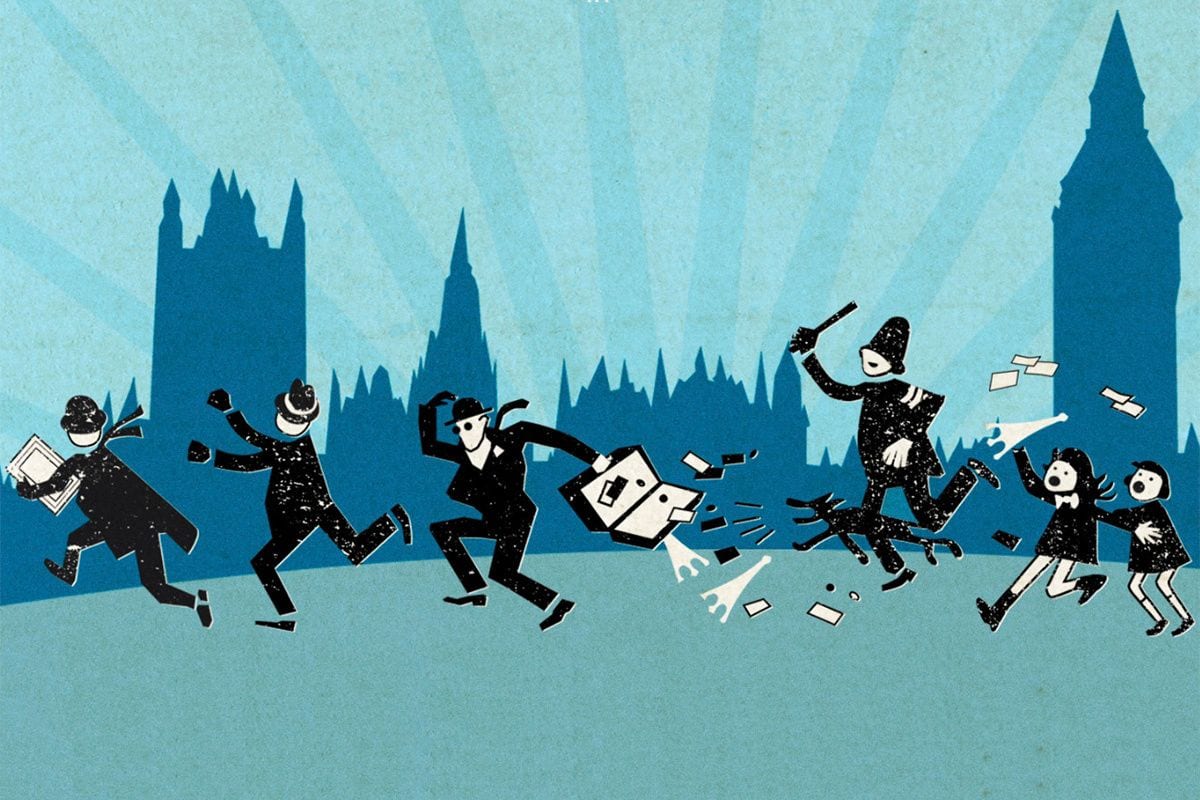
(image: excerpted from Kino Lorber Blu-ray cover)
The audience identifies with criminal behavior once again in The Lavender Hill Mob, another class-conscious comedy in which little guys decide to pull off a heist. Whereas Passport to Pimlico opens with a false impression of taking place in a Latin American country, The Lavender Hill Mob really does open in Rio, where Henry Holland (Guinness, Oscar-nominated) is a doyen of high society, hobnobbing with ambassadors, congratulating jockeys, heavily tipping waiters, and flirting with a gorgeous model played by not-yet-famous Audrey Hepburn.
To his dining companion, Holland recounts the flashback of how for 20 years he worked as “a non-entity” amid thousands like him, anonymous interchangeable men in bowler hats swarming through a London now marked by remnants of the Blitz. He escorts vans of gold bullion on its way to the Bank of England and waits for the right partners to come along. Meanwhile, he lives in a residential hotel in Lavender Hill, where he reads bloody, slangy, pulpy crime novels to neighbor Mrs. Chalk (Marjorie Fielding) and they discuss the fine points of being “taken for a ride”.
The fateful day arrives when Alfred Pendlebury (Stanley Holloway) moves in. He runs Gewgaws Ltd., a firm that molds tchotchkes for tourists. Brits travel on holiday to Paris and buy miniature souvenirs of Eiffel Towers to take home, little knowing they’re made in London. This is one of screenwriter T.E.B. Clarke’s wonderful details on the absurdities and ironies of capitalism; he won an Academy Award for this script.
One of the script’s smoothly developed ideas is that the notion of molding the gold into Eiffel Towers and shipping them to Paris enters at once into the minds of Holland and the audience, so that it almost seems like our idea and our heist. Thus, likely being the same kind of workaday non-entities ourselves, we are with Holland all the way on a plot with as many missteps as miracles. Future comedy stars Sid James and Alfie Bass round out the “mob” as professional crooks, and also seen are Ealing regulars like Sydney Tafler and Edie Martin.
Another subtle and effective detail is that when the Scotland Yard Inspector (John Gregson) is “introduced”, the viewer is given a moment to recognize that we’ve already seen him as Holland’s dinner companion in the framing story. This redefines our interpretation of events and clues us in that the jig is somehow going to be up, without spelling out how. For a good while, Holland really pulls the wool over police eyes, leading a newsreel announcer to say “Oh, plucky little Holland” in another winking reference to the recent war.
Jeremy Arnold’s companionable commentary offers revealing quotes from Ealing honcho Balcon, who observed that the atmosphere of postwar England was marked by “a mild anarchy” and that he saw these comedies as “a safety valve for our most antisocial impulses.” He also believed that English films should reflect England and be English (as opposed to aping Hollywood, for example), as he thought “the only sort of nationalism that’s worth a damn is cultural nationalism.”
Arnold points out how Crichton and Slocombe arrange certain scenes into economical, unfussy long takes that give the actors room to breathe without calling attention to style. A stylistic highlight that does call delirious attention to itself, however, is when the camera shares the subjectivity of the heroes in the dizzying Eiffel Tower sequence. If you’re on an Ealing jag, this scene may recall the upside-down shot in
Kind Hearts and Coronets. Above all, the scene crystallizes frantic laughter and madness, merging viewer and characters and the film experience.
This scene, and the whole picture, is brightly scored by Auric and extremely well edited by Seth Holt, who went on to direct a few excellent thrillers before dying young. Like Slocombe, Holt got into Ealing via wartime documentaries. Like Hamer, he died too young of ruined health or we’d have more good pictures by him.
Other extras include a TV interview with Clarke, an audio interview with Crichton, and an intro by Martin Scorsese. The anecdote Clarke tells of how he broke into Ealing from journalism doesn’t match the version given by Arnold, but we’ll wager the latter is probably more accurate.
This highly successful movie, which won the BAFTA for Best British Picture, was followed into theaters two months later by Mackendrick’s
The Man in the White Suit, which reunited several key players from Kind Hearts and Coronets: Guinness, Greenwood, Slocombe and writer Dighton, now scripting with Mackendrick and Roger MacDougall in a gentler and sadder satire with a mild touch of science fiction. MacDougall, who was adapting his own play, would go on to write Jack Arnold’s The Mouse That Roared (1959), a US co-production with Peter Sellers that’s a perfect example of an Ealing comedy not made by Ealing.
The Man in the White Suit, Dir. Alexander Mackendrick, 1951. [Kino Lorber]
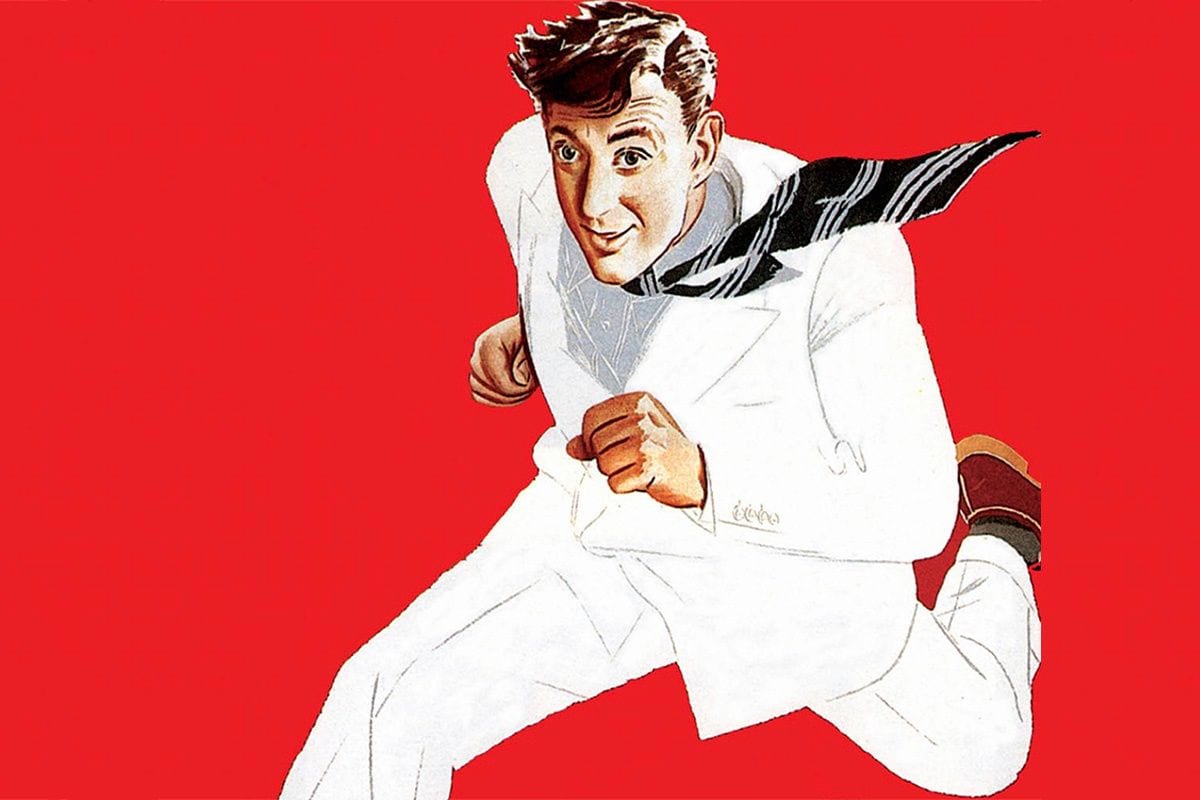
(image: excerpted from Kino Lorber Blu-ray cover)
The Man in the White Suit stars Guinness as Sidney Stratton, a brilliant chemist working on a fibre that will never stain or wear out. In a sour inversion of the famous saying, this story knows that if you build a better mousetrap, the world will try to beat you to death, for innovation is a threat to industry and the economic status quo. With the implied moral and intellectual purity of his angelically white suit, which both makes him “a knight in shining armor” and a beacon to be despised, Sidney stands out from his fellows as a creative oddity in this world.
He also seems completely free of any emotion or concern besides achieving the creative goal that consumes him as a monomania. He’s a “little man”, but as the interviewees point out in an extra, he’s not supported by a community as in Clarke’s scripts. The community is against him. He’s insular, almost an abstraction incapable of empathy, and that Guinness can invest him with appealing qualities is a tribute to his skill at finding the humanity in a caricature.
After a first half in which Sidney butts his head against the walls of established business practice and causes lots of explosions, so that the factory piles up sandbags like in the trenches or during the Blitz, the second half escalates into ever more frantic activity and chases that are beautifully staged, shot and edited.
Ernest Thesiger, best remembered as Dr. Pretorious in James Whale’s The Bride of Frankenstein (1935), shows up as a spidery tottering patriarch of industry, devoted to aborting another monster that will bankrupt them all. He wheezes asthmatically and swings his cane before narrowing his beady eyes to the business at hand, which is putting the monetary value on everything. Just turn him a few notches from comedy into drama and he could be a character in Mackendrick’s Sweet Smell of Success.
The workers and fatcats may seem at odds when presented scowling on opposite sides of a confrontational composition — the workers on the left side of the screen, natch — but this factory finally has no distinction between capital and labor, just like the private train in The Titfield Thunderbolt. Both forces want to suppress an invention that will gut the industry.
Before the plot reaches that point, capital and labor are represented by two different women attracted to Sidney: the owner’s daughter Daphne (Greenwood) and fiery worker Bertha (Vida Hope), who frets about vested interests and the heavy hand of monopoly. Daphne is more willing to see her father’s industry come crashing down, probably thanks to her relationships to father (Cecil Parker) and a boyfriend (Michael Gough). When Bertha remarks on capitalism, she’s putting her finger on the film’s most intransigent theme: this is the world we’ve constructed, and now it constructs us.
Ultimately, neither force can have Sidney, who will always be a dangerous individualist and outsider, incapable of accommodating himself or compromising. The only moment that briefly gets through to him is a poignant comment by his little old landlady (Edie Martin) who takes in washing for a few pennies on the side. He’s struck dumb because there’s no answer to the human dilemma she presents; this person, who’s been good and generous to him, is among those who will suffer for his progress.
The film is narrated by Parker’s capitalist, but neither film nor viewer can finally decide if Sidney’s presence is good or bad, if he brings peace or a sword. This comedy expresses a powerful, provocative idea in 85 brisk minutes, and its effects linger long after.
Sidney’s arc from unlikely ambition to heady success to evaporation amid a hostile crowd bears similarity to his role in Henry Cass’ non-Ealing comedy,
Last Holiday (1950), and unfortunately also reflects the fortunes of Ealing. By the end of the decade, the studios had been sold to the BBC and Balcon moved his unit to MGM’s Borehamwood Studios for a few tapering years before the Ealing brand folded shop. The good news is that after changing hands several times, the studio remains active. For example, it was used in the Downtown Abbey series.
Although the Ealing name has been revived in the new century, film buffs will always regard its incandescent era as that period in the 1940s and ’50s when it held up a scrappy and schizoid mirror to postwar England’s depressions and aspirations, now warm and cozy, now dark and rueful. Oh, plucky little Ealing.
What makes a film an ‘Ealing’ film? Why should we cry at ‘Mandy’? What has ‘The Man in the White Suit’ got to do with the atomic bomb? And what might Ealing …
- Strong Women and Dark Doings: 'Three Wicked Melodramas from ...
- Film Archiving: The Importance of Enlightening Those Audiences ...
- Hobson's Choice (Criterion Collection) - PopMatters
- 'Perfect Understanding' Probes Timeless Questions About ...
- Time Only Makes the Cult Grow Stronger: Kids in the Hall's 'Brain ...
- Feeling at House in Downton Abbey - PopMatters
- A Fish Called Wanda - Collectors Edition (1988) - PopMatters
- Who Dares Enter The House That Dripped Blood and the Asylum ...
- 'Dead of Night' Haunts Above and Beyond Its Imitators - PopMatters
- They Came to a City, Basil Dearden (film review) - PopMatters
- 'Their Finest Hour' Offers Five British WWII Classics - PopMatters
- Charles Chrichton's 'A Fish Called Wanda' (review) - PopMatters

